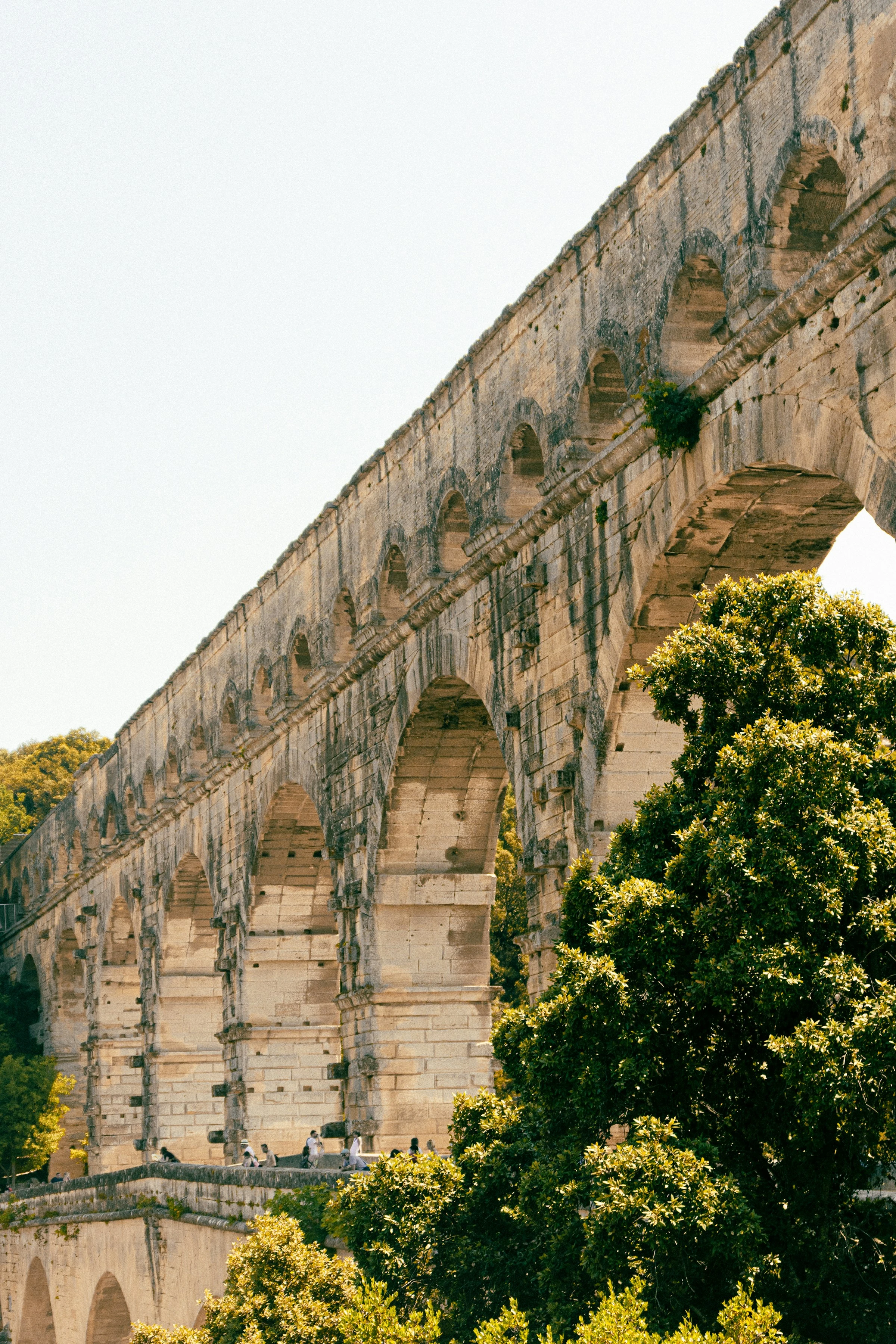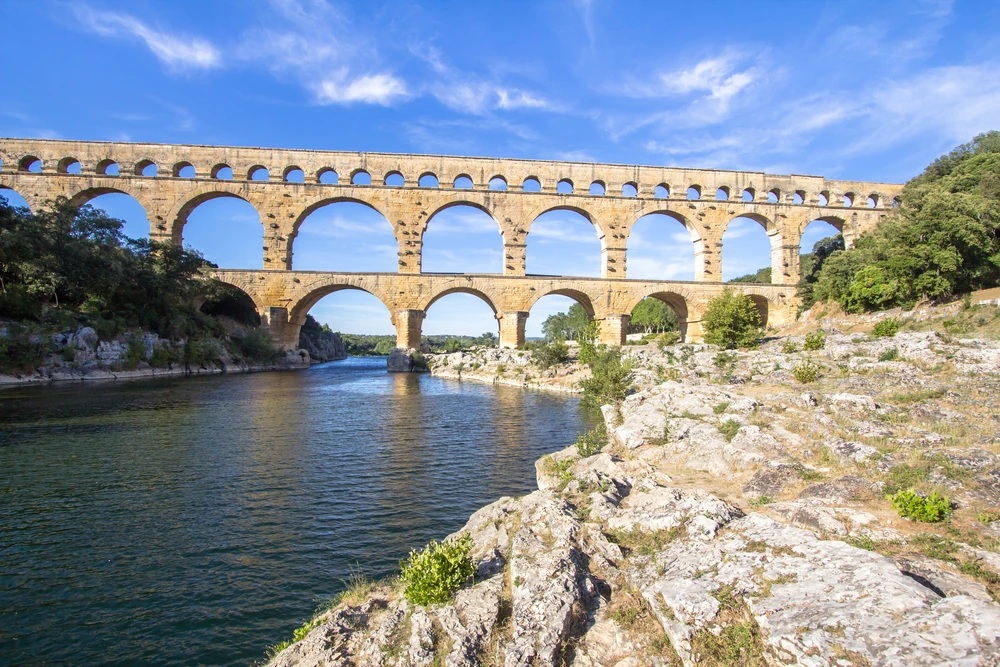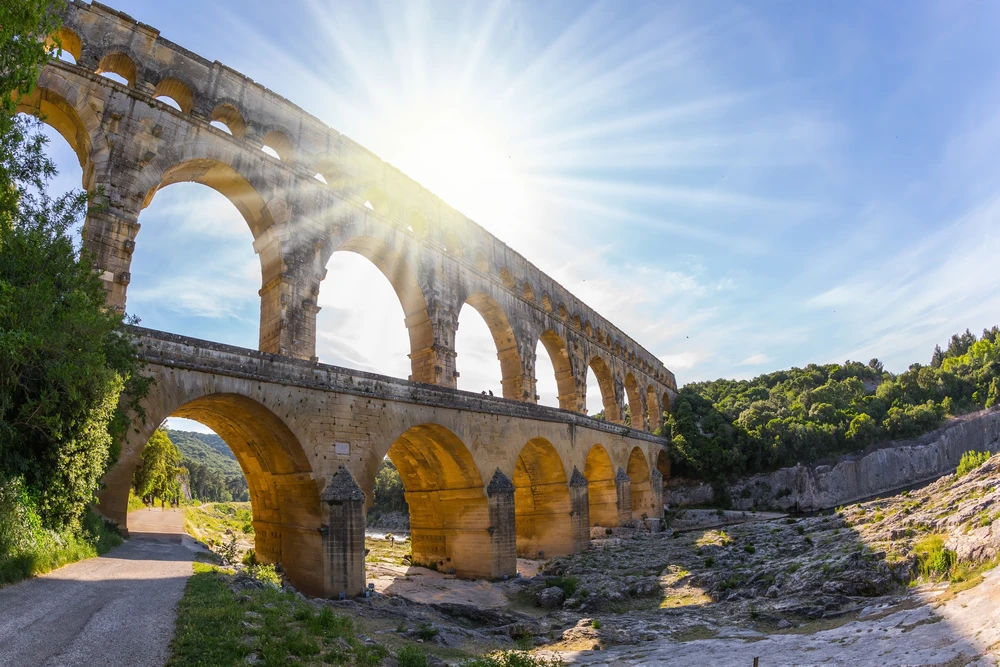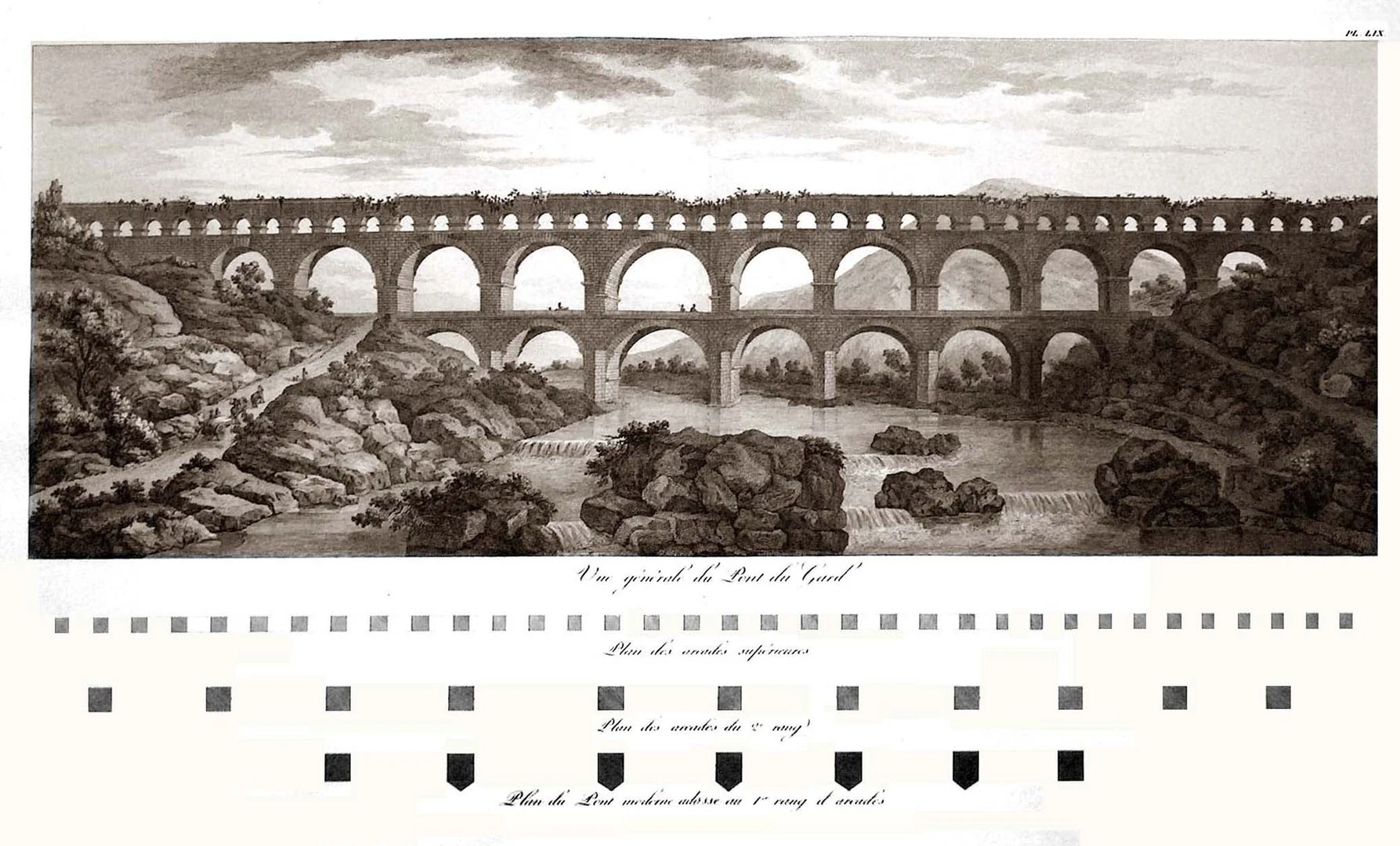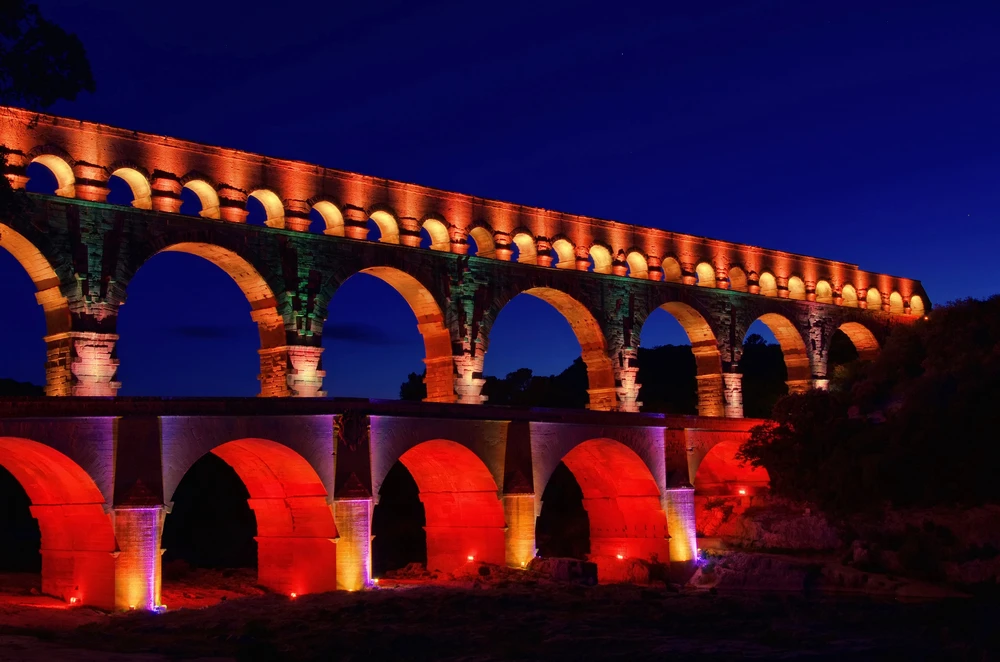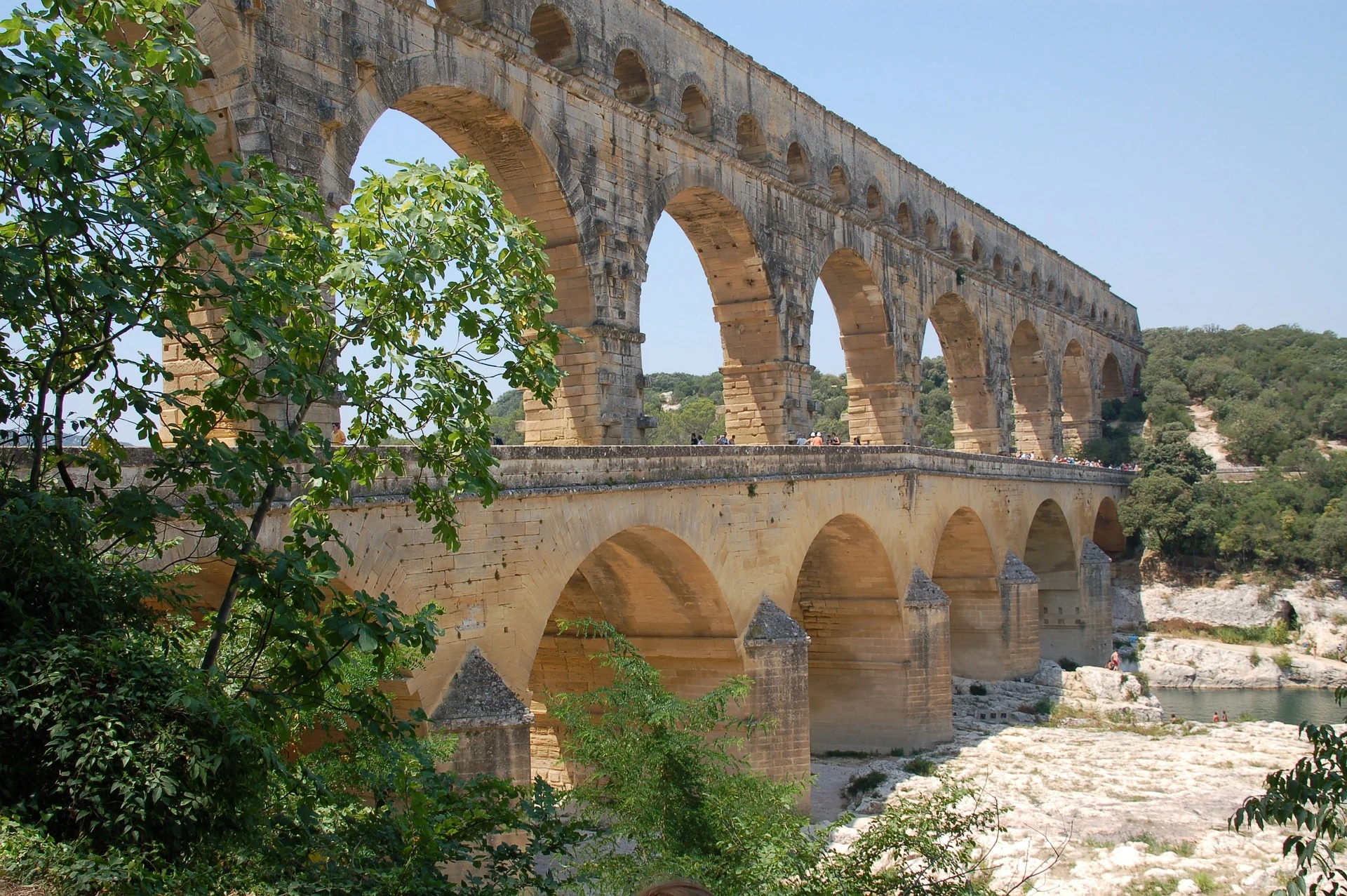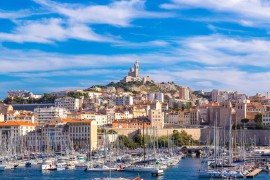There may be translation errors. Our translator has a funny face, and we wonder if he's been drinking too much Rhône Valley wine...
The secrets of the Pont du Gard
Beautiful photo of the Pont du Gard by Chloé Martin on Unsplash
Pont du Gard figures
Built around 50 A.D., it is almost 2000 years old. It rises 49 metres above the riverbed (the Gardon). It's the longest Roman aqueduct bridge in the world: 275 metres long. It has three levels, each composed of arches. There are 6 from the ground (over 20 meters high), 11 on the upper level and 35 on the top level. In midsummer, it can gain 5 mm in height due to the expansion of the stones.
A popular tourist destination for many years.
Over 1,400,000 tourists visit the site every year. They are not the first to discover the site, as many historical figures have visited it. In the 16th century, King Charles IX visited during his tour of France, as did Henri III and Henri IV. In 1660, Louis XIV made a detour to admire the construction .
The Pont du Gard is a bridge to bring water to Nîmes
The Pont du Gard has a function that isn't necessarily that of carrying people or carts over the river. It's part of a much larger and more complex complex system that brought running water to the Gallo-Roman city of Nemausus, now known as Nîmes (which boasts a superb Gallo-Roman heritage, including the famous Nîmes arena). The total length was 52 kilometers. At its peak, it delivered 450 liters of water per second. It fell victim to limescale deposits, eventually clogging the pipes, and it seems to have ceased operating after 4 centuries (which is already an enormous amount when you consider what's being built today, and you sometimes wonder if it's going to last more than 40 years...).
View of the Pont du Gard. Photo chosen by monsieurdefrance.com: CAHKTviadepositphotos.
An almost mortarless construction.
What's most astonishing about the Pont-du-Gard's design is that it practically stands on its own by the sheer force of the attraction and arrangement of the stones. Very little cement, or rather mortar, is used. Roman mortar (extremely strong) is only used at the top for the smaller arches. For larger arches, oak tenons help hold the stones in place. Some of the stones weigh over 6 tonnes , and were made to measure in the quarry before being corrected on site. Some historians claim that it is made up of 11,000,000 blocks of stone, large or small, and weighs at least 50,000 tonnes - 5 times the Eiffel Tower. Building the bridge alone took 1,000 workers between 3 and 5 years. It took 11 to build the entire aqueduct.
And spans a river
The Pont du Gard was built by the Gallo-Romans to span the Gardon, which is also the Gard (the Gard is the union of the Gardon d'Uzès and the Gardon d'Anduze), a river that flows for 71 km before emptying into the Rhône . The Gard can be very high and tumultuous, even if it doesn't appear so in photographs. In 2002, it reached 3/4 of the first arches.
The Pont du Gard in the sun: Photo chosen by monsieurdefrance.com kavramm via depositphotos.
Lucky phalluses on the Pont du Gard
Roman builders left their mark. Often to protect the monument by magic. Phallic sculptures , for example, were thought to bring good luck. They protected passers-by, so they were placed everywhere: in the streets, on houses and ... on the Pont du Gard (some are really funny, with little bells). There are also traces of the repairers who took care of them over the centuries, and brands with names dating back to the 17th or 18th century.
A Bridge for centuries
Even after the aqueduct stopped supplying water, the bridge remained and men used it as a bridge. This saved it, but also damaged it. For example, the piers were indented to allow heavy traffic to pass more easily. In the 18th century, the first storey was widened to reinforce the whole and above all to allow road traffic to continue (by cart, horse or foot). One of France's oldest historic monuments, it was first listed in 1840 and has been a World Heritage Site since 1985.
The Pont du Gard in 1804. Illustration chosen by monsieurdefrance.com: By Charles-Louis Clérisseau - Antiquités de la France, pub. 1804, Domaine public, https://commons.wikimedia.org/w/index.php?curid=11393090
Restorations throughout history
One of the things that saved the Pont du Gard was the French passion for Roman antiquity from the Renaissance onwards. It was this interest that led to several rescue campaigns over the centuries. In 1640, the Bishop of Nîmes launched a fund to consolidate the monument. Further work was carried out in 1696 to consolidate the piers. In 1747, the road bridge at the base was completed. Further work was carried out in 1842 (taking advantage of the opportunity to dig a staircase in one of the piers to lead to the top). In 2000, the surrounding area was restructured to protect the bridge from the influx of tourists. The site became pedestrian-only.
How to visit the Pont du Gard
Parking is charged, as is the site. In 2024: 8 euros for the monument and 9 euros for the parking lot. For further information, click here.
You can also visit the Museum dedicated to the town, which presents its history and plunges you into Roman times in a 6,000 m2 building.
In summer, it is illuminated every evening (July and August).
In summer, the Pont du Gard is illuminated at night. Photo chosen by monsieurdefrance.com: Kassandra2 via depositphotos.
How to get to the Pont du Gard
N.B The parking lots are open all year round from 8am to midnight (info 2024). They allow you to see the site up close.
Pont du Gard address
Since it's a bridge, there are two banks, so two addresses:
Parking Rive gauche (the side of the museum); Pont du Gard, 400 Route du Pont du Gard, 30210 Vers-Pont-du-Gard (this is the name of the commune)
Parking Rive droite: 24 Avenue du Pont du Gard 30 210 REMOULINS
GPS point Left bank: 43.9525690 / 4.5360469 Right bank: 43.9494753 / 4.5428712
The Pont du Gard up close. Photo chosen by monsieurdefrance.com: by Frits Kappers from Pixabay
By car
Paris is 6H50 via the A6 and A7. Lyon is 2H20 (235 kms) Marseille 1H30 (126 kms), Nîmes 31 mn (25 kms).
By train :
The nearest stations are Nîmes, Avignon or Avignon TGV.
By Plane
Marseille Provence airport (1 hour from Arles)
Avignon airport - 84140 Montfavet - www.avignon.aeroport.fr (50 mn from Arles)
Nîmes Grande Provence Méditérranée Airport - 30800 Saint-Gilles - www.nimes.aeroport.fr (30 mn from Arles)
Around the Pont du Gard
You're not far from Nîmes, which is well worth a visit, not least for its famous arena and Maison Carrée (recently declared a UNESCO World Heritage Site). Avignon is not far away, with the Palais des Papes. And it's wine country, with the wines of the Rhône Valley .

